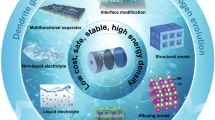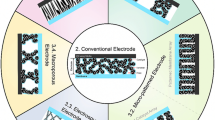Abstract
A finite strain theory for electro-chemo-mechanics of lithium ion battery electrodes along with a monolithic and unconditionally stable finite element algorithm for the solution of the resulting equation systems is proposed. The chemical concentration and the displacement fields are introduced as independent variables for the formulation diffusion-mechanics coupling. The electrochemistry of the surface reaction kinetics is imposed at the boundary in terms of the Butler–Volmer kinetics. The intrinsic coupling arises from both stress-assisted diffusion in electrodes and ion mass flux induced volumetric deformation. We demonstrate the theoretical modeling aspects and algorithmic performance through representative initial boundary value problems. The proposed finite strain theory is especially well suited for electrode materials like silicon which exhibit large volume changes during lithium insertion/ extraction. We demonstrate the inadequacy of small-strain theories for diffusion-mechanics coupling in silicon based anode materials. The proposed numerical algorithm shows excellent performance, demonstrated for 2D and 3D representative numerical examples.




















Similar content being viewed by others
Notes
Explicit definition of pressure gradient: \({\mathcal C}^0\) continuous shape functions are poor in the computation of the pressure gradient term, which is needed for the computation of Li\(^+\) ion flux (44)\(_2\). In order to overcome this difficulty, we propose a semi-implicit finite element scheme based on an explicit definition of the pressure gradient, in a sense of a selective staggered scheme. Here, we employ a projection algorithm that allows a straightforward computation of the gradient in terms of \({\mathcal C}^0\)-shapes. To this end, an additional negative pressure field \(\mathfrak {p}\) is introduced and locally defined by the residual
$$\begin{aligned} \mathfrak {r}{:}= \mathfrak {p}+\frac{1}{3}\hbox {tr}\tilde{\varvec{\sigma }}_n=0 \end{aligned}$$(65)in terms of the stress \(\tilde{\varvec{\sigma }}_n\) at time \(t_n\), yielding the weak and incremental form
$$\begin{aligned} G^{\mathfrak {p}} = \int _{{\mathcal B}} \delta \mathfrak {p}\cdot \mathfrak {r}\,dV = 0 \quad \text{ and }\quad \varDelta G_\mathrm{ext }^{\mathfrak {p}} = \int _{{\mathcal B}} \delta \mathfrak {p}\varDelta \mathfrak {p}\,dA \, . \end{aligned}$$(66)Introducing the \({\mathcal C}^0\) element interpolation \(\mathfrak {p}^h({\varvec{ X }}) = {\varvec{ N }}^e_\mathfrak {p}({\varvec{ X }}) {\varvec{ d }}_\mathfrak {p}\) consistent with (62), one obtains the finite element residual and tangent matrix
$$\begin{aligned} {\varvec{ R }}_{\mathfrak {p}} = \mathop {{\mathbf {\mathsf{{A}}}}}\limits _{e=1}^{N_e} \int _{\partial {\mathcal B}^{el}} \!\! {\varvec{ N }}_\mathfrak {p}^{e} \mathfrak {r}\,dV \quad \text{ and }\quad {\varvec{ K }}_{\mathfrak {p}\mathfrak {p}} = \mathop {{\mathbf {\mathsf{{A}}}}}\limits _{e=1}^{N_e} \int _{\partial {\mathcal B}^{h}_{el}} \!\! {\varvec{ N }}_\mathfrak {p}^{e\,T} {\varvec{ N }}_\mathfrak {p}^{e} \,dV \, . \end{aligned}$$(67)in addition to (64). Then, the pressure gradient is locally approximated by
$$\begin{aligned} \nabla p({\varvec{ X }}) {:}= {\varvec{ B }}^e_\mathfrak {p}({\varvec{ X }}) {\varvec{ d }}_\mathfrak {p}\end{aligned}$$(68)and constant within the times step \([t_n,t_{n+1}]\) under consideration. The semi-implicit schme that uses this approximation is very robust.
References
Anand L (2012) A Cahn–Hilliard-type theory for species diffusion coupled with large elastic–plastic deformations. J Mech Phys Solids 60:1983–2002
Baggetto L, Niessen RAH, Roozeboom F, Notten PHL (2008) High energy density all-solid-state batteries: a challenging concept towards 3d integration. Adv Funct Mater 18:1057–1066
Bohn E (2011) Partikel-modell für lithium-diffusion und mechanische spannungen einer interkalationselektrode. Ph.D. thesis, Karlsruher Institut für Technologie
Bower AF, Guduru PR (2012) A simple finite element model of diffusion, finite deformation, plasticity and fracture in lithium ion insertion electrode materials. Model Simul Mater Sci Eng 20:1–20
Bower AF, Guduru PR, Sethuraman VA (2011) A finite strain model of stress, diffusion, plastic flow and electrochemical reactions in a lithium-ion half-cell. J Mech Phys Solids 59:804–828
Burch D, Singh G, Ceder G, Bazant M (2008) Phase-transformation wave dynamics in LiFePO\(_4\). Solid State Phenom 139:95–100
Cahn JW (1959) Free energy of a nonuniform system. II. Thermodynamic basis. J Chem Phys 30:1121–1124
Cahn JW, Hilliard JE (1957) Free energy of a nonuniform system. I. Interfacial free energy. J Chem Phys 28:258–267
Chan CK, Peng H, Lui G, McIlwrath K, Zhang XF, Huggins RA, Cui Y (2008) High-performance lithium battery anodes using silicon nanowires. Nanotecnology 3:31–35
Cheng YT, Verbrugge MW (2008) The influence of surface mechanics on diffusion induced stresses within spherical nanoparticles. Appl Phys Lett 104:083521
Chon MJ, Sethuraman VA, McCormick A, Srinivasan V, Guduru PR (2011) Real-time measurement of stress and damage evolution during initial lithiation of crystalline silicon. Phys Rev Lett 107:045503
Christensen J (2010) Modelling diffusion-induced stress in li-ion cells with porous electrodes. J Electrochem Soc 157:A366–A380
Christensen J, Newman J (2006) A mathematical model of stress generation and fracture in lithium manganese oxide. J Electrochem Soc 153:A1019–A1030
Christensen J, Newman J (2006) Stress generation and fracture in lithium insertion materials. J Solid State Electrochem 10:293–319
Cui LF, Ruffo R, Chan CK, Peng H, Cui Y (2009) Crystalline–amorphous core–shell silicon nanowires for high capacity and high current battery electrodes. Nano Lett 9:491–495
Deshpande R, Cheng YT, Verbrugge MW (2010) Modeling diffusion-induced stress in nanowire electrode structures. J Power Sources 195:5081–5088
Doyle M, Fuller TF, Newman J (1993) Modeling of galvanostatic charge and discharge of the lithium/polymer/insertion cell. J Electrochem Soc 6:1526–1533
Doyle M, Newman J, Gozdz AS, Schmutz CN, Tarascon JM (1996) Comparison of modeling predictions with experimental data from plastic lithium ion cells. J Electrochem Soc 143:1890–1903
Du W, Gupta A, Zhang X, Sastry AM, Shyy W (2010) Effect of cycling rate, particle size and transport properties on lithium-ion cathode performance. Int J Heat Mass Transf 53:3552–3561
Golmon S, Maute K, Lee SH, Dunn ML (2010) Stress generation in silicon particles during lithium insertion. Appl Phys Lett 97:033111
Gurtin ME (1996) Generalized Ginzburg–Landau and Cahn–Hilliard equations based on a microforce balance. Phys D 92:178–192
Huggins R, Nix W (2000) Decrepitation model for capacity loss during cycling of alloys in rechargeable electrochemical systems. Ionics 6:57–63
Kasavajjula U, Wang C, Appleby AJ (2007) Nano- and bulk-silicon-based insertion anodes for lithium-ion secondary cells. J Power Sources 163:1003–1039
Miehe C, Hildebrand F, Böger L (2014) Mixed variational potentials and inherent symmetries of the Cahn–Hilliard theory of diffusive phase separation. Proc R Soc A Math Phys 470:20130641
Miehe C, Ulmer H, Mauthe S (2014) Formulation and numerical exploitation of mixed variational principles for coupled problems of Cahn–Hilliard-type and standard diffusion in elastic solids. Int J Numer Methods Eng 99:737–762
Newmann J, Thomas-Alyea KE (2004) Electrochemical systems, 3rd edn. Wiley, Hoboken
Seo JH, Chung M, Park M, Han SW, Zhang X, Sastry AM (2011) Generation of realistic particle structures and simulations of internal stress: anumerical/AFM study of LiMn\(_2\)O\(_4\) particles. J Electrochem Soc 158:A434–A442
Sethuraman V, Chon M, Shimshak M, Winkle NV, Guduru P (2010) In situ measurement of biaxial modulus of si anode for li-ion batteries. Electrochem Commun 12:1614–1617
Sethuraman V, Srinivasan V, Bower AF, Guduru PR (2010) In situ measurements of stress-potential coupling in lithiated silicon. J Electrochem Soc 157:A1253–A1261
Sethuraman VA, Chon MJ, Shimshak M, Guduru VSPR (2010) In situ measurements of stress evolution in silicon thin films during electrochemical lithiation and delithiation. J Power Sources 195:5062–5066
Singh GK, Ceder G, Bazant MZ (2008) Intercalation dynamics in rechargeable battery materials: general theory and phase-transformation waves in LiFePO\(_4\). Electrochim Acta 53:7599–7613
Yao Y, McDowell MT, Ryu I, Wu H, Liu N, Hu L, Nix WD, Cui Y (2011) Interconnected silicon hollow nanospheres for lithium-ion battery anodes with long cycle life. Nano Lett 11:2949–2954
Zhang X, Sastry AM, Shyy W (2007) Numerical simulation of intercalation-induced stress in li-ion battery electrode particles. J Electrochem Soc 154:A910–A916
Zhang X, Sastry AM, Shyy W (2008) Intercalation-induced stress and heat generation within single lithium-ion battery cathode particles. J Electrochem Soc 155:A542–A552
Zhao K, Tritsaris GA, Pharr M, Wang WL, Okeke O, Suo Z, Vlassak JJ, Kaxiras E (2012) Reactive flow in silicon electrodes assisted by the insertion of lithium. Nano Lett 12:4397–4403
Acknowledgments
Support for this research was provided by the German Research Foundation (DFG) for the Cluster of Excellence Exc 310 Simulation Technology at the University of Stuttgart.
Author information
Authors and Affiliations
Corresponding author
Rights and permissions
About this article
Cite this article
Dal, H., Miehe, C. Computational electro-chemo-mechanics of lithium-ion battery electrodes at finite strains. Comput Mech 55, 303–325 (2015). https://doi.org/10.1007/s00466-014-1102-5
Received:
Accepted:
Published:
Issue Date:
DOI: https://doi.org/10.1007/s00466-014-1102-5




